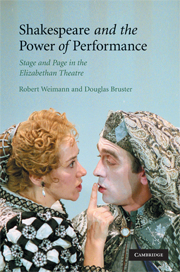Book contents
- Frontmatter
- Contents
- Acknowledgments
- Introduction
- Chapter 1 “Moralize two meanings” in one play: contrariety on the Tudor stage
- Chapter 2 Performance, game, and representation in Richard III
- Chapter 3 Mingling vice and “worthiness” in King John
- Chapter 4 Clowning: agencies between voice and pen
- Chapter 5 Clowning at the frontiers of representation
- Chapter 6 Cross-dressing and performance in disguise
- Chapter 7 Personation and playing: “secretly open” role-playing
- Chapter 8 Character/actor: the deep matrix
- Chapter 9 Character: depth, dialogue, page
- Chapter 10 King Lear: representations on stage and page
- Notes
- Index
- References
Chapter 6 - Cross-dressing and performance in disguise
Published online by Cambridge University Press: 22 September 2009
- Frontmatter
- Contents
- Acknowledgments
- Introduction
- Chapter 1 “Moralize two meanings” in one play: contrariety on the Tudor stage
- Chapter 2 Performance, game, and representation in Richard III
- Chapter 3 Mingling vice and “worthiness” in King John
- Chapter 4 Clowning: agencies between voice and pen
- Chapter 5 Clowning at the frontiers of representation
- Chapter 6 Cross-dressing and performance in disguise
- Chapter 7 Personation and playing: “secretly open” role-playing
- Chapter 8 Character/actor: the deep matrix
- Chapter 9 Character: depth, dialogue, page
- Chapter 10 King Lear: representations on stage and page
- Notes
- Index
- References
Summary
During the past three decades, the subject of cross-dressing in Shakespeare's theatre has been greatly advanced by feminist criticism. Noting that sartorial displays both on stage and off routinely appealed to a society conscious of the power inherent in clothing (a power that rendered costumes a primary element in the theatres' montage of attractions), critics have productively explored both the boy actor's donning of female costume and female characters' strategic adoption of male garb. Studies by Jean Howard, Laura Levine, Sue-Ellen Case, Lisa Jardine, Karen Newman, and Peter Stallybrass, among others, have broadened the conventional portrait of cross-dressing generated, in Stephen Orgel's words, by “three centuries of theatre historians, who have treated it as a minor point, of interest primarily for its effect on disguise plots.” Coinciding with the field's heightened interest in the construction and representation of gender and sexuality, recent investigations have opened up vistas on both the practice and the implications of cross-dressing, inside and outside the walls of the early modern playhouses. If a primary aim of criticism attuned to feminist interests is, as Lisa Jardine writes in the preface to her landmark study, Still Harping on Daughters, “to retrieve agency for the female subject in history” and to do so “at the intersection of systems of behaviour, customs, beliefs,” few studies have done more to meet this goal than those which have shed light on the performance of female roles by young male actors in London's theatres.
- Type
- Chapter
- Information
- Shakespeare and the Power of PerformanceStage and Page in the Elizabethan Theatre, pp. 117 - 138Publisher: Cambridge University PressPrint publication year: 2008



